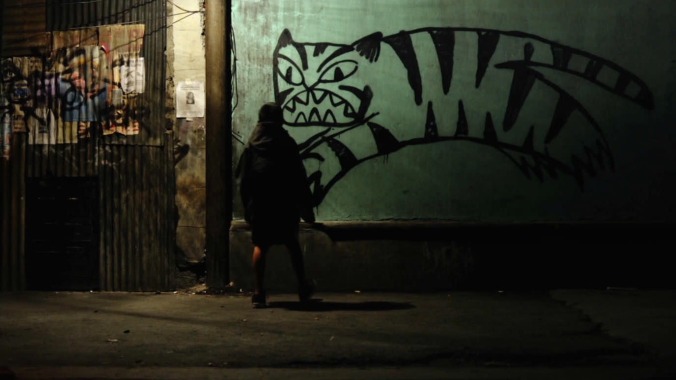In her native Mexico, Issa López is an established—and celebrated!—novelist, director, and screenwriter. It’s those of us north of the border that have been slow to catch up. López’s third feature film, Tigers Are Not Afraid, seems poised to serve as her breakthrough in the U.S., riding praise from the likes of Stephen King and Guillermo del Toro into American movie theaters before making its streaming debut on Shudder. There’s much about this horror-fantasy that’s uniquely Latin American: Its magical realist sensibility, for example, as well as its cozy relationship with death. But there’s also a lot about it that will appeal to broader U.S. audiences, given that López’s approach to kids-in-peril adventure combines wonder and danger in a distinctly Spielbergian way.
The story takes place in an unnamed border city plagued by drug violence, where—as a title card at the beginning of the film states—hundreds of thousands of people have gone missing in the past 10 years, and “there are no numbers for the children the dead and the missing have left behind.” Estrella (Paola Lara) is one of these children, a 10-year-old schoolgirl whose mother suddenly and mysteriously disappears at the beginning of the film. Sent home after a gang shooting at her school by a teacher who gives her three pieces of chalk—each one good for a wish—Estrella sits overnight in an empty apartment waiting for her mom to return. Instead, at first light she’s greeted by a mournful, sighing ghost, the first of many that will appear to her throughout the film. The arrival of the spirit signals two devastating truths: Estrella’s mother is dead, and she will be too if she doesn’t flee.
Wandering the streets with nowhere to go, Estrella joins an impromptu family of orphaned street children led by the moody El Shine (Juan Ramón López), a little boy who acts like a macho gangster. Shine stole a gun and a cellphone from a cartel member named Caco (Ianis Guerrero) shortly before Estrella joined their little gang, and now Caco and his boss, El Chino (Tenoch Huerta), have come to get them back. Tigers Are Not Afraid pulls no punches when it comes to violence against children as young as 4 years old, and El Chino and his gang have no compunction about offing little kids with the same indifference with which they take adult lives. So while the film is told from a child’s perspective, with a firm belief in wishes and a love of playing pretend, the stakes of the kids’ adventure as they try to stay one step ahead of Chino and his gang are literally life-and-death.
This same blend of whimsy and destruction informs the film’s visuals, as Estrella, Shine, and their young companions duck between bombed-out buildings trying to stay out of sight. An abandoned theater becomes a zoo when the kids find colorful koi swimming in a filthy puddle. A dingy warehouse is lit by orange flames from a burning piano. The rooftop clubhouse where the boys are living when Estrella first arrives is draped in sheets of plastic and scavenged junk, a gritty urban counterpart to the Lost Boys’ hideout from Spielberg’s Hook. The graffiti that covers nearly every outdoor surface periodically comes to life, dancing and swaying in joy and in grief. All the while, Estrella is tailed by a snaking stream of blood that bends and twists around every corner, a reminder of what awaits them if the cartel ever finds her and her friends.
The film’s English title (in Spanish, it’s called Vuelven, meaning “they come back”) comes from an affecting but underdeveloped thematic through-line about fairy-tale characters—which, for these kids, might as well include tigers, an animal they’ve never seen and will probably never see in real life. But Tigers Are Not Afraid is at its most effective when it uses its fertile imagination to terrify. Estrella’s ghosts, which increase in number and intensity as El Chino draws closer, are both chilling and deeply sad, and the scene where she’s confronted by dozens of spirits in a room full of furniture draped in white sheets is positively nightmare-inducing. With that in mind, it’s too bad that the camerawork becomes distractingly shaky in several key sequences, throwing off the composition and cheapening the look of this otherwise well-staged and well-executed film. Along with a few frustrating character beats, these small technical hiccups keep Tigers Are Not Afraid from rising quite to the level of a masterpiece. But as López’s career continues to ascend, there’s no doubt that she’ll meet that challenge sooner rather than later.


